Recycling of Cement–Wood Board Production Waste into a Low-Strength Cementitious Binder
Abstract
1. Introduction
2. Results and Discussion
2.1. Effect of Curing Conditions
2.2. Effect of Increasing the W/B Ratio
2.3. Influence of Superplasticizer Addition
2.4. Affect of Raw Material Sifting
2.5. Effect of the Increase in Grinding Time
2.5.1. W/B Ratio of 0.7
2.5.2. Mini-Slump Test Diameter
3. Materials and Methods
3.1. Raw Materials
3.2. Mixture Design and Sample Preparation
3.3. Characterization Techniques
4. Conclusions
- After the data of the dust granulometry, it has been concluded that 99% of the particles are less than 2 mm, and it can be seen that large wood particles can be separated from the cement by sifting. The sifting process also improves the workability of the material, accelerates the onset time of setting, increases the bulk density of the samples by an average of 400 kg/m3, and improves the mechanical compressive strength by 3.55 MPa on day 28;
- The X-ray diffractograms for the dust showed the hydrate phases of portlandite, calcite, and calcium silicates, while the X-ray diffractograms for unsifted dust showed the amorphous cellulose phases.
- Mechanical treatment of the dust does not significantly affect its mineralogical composition. The sifting process affects the surface area of the dust, the surface area of the unsifted dust is 7.649 m2/g, and that of the sifted is 8.990 m2/g. Increasing the grinding time does not significantly affect the surface area of the dust;
- Thermogravimetric analysis showed weight loss for unsifted dust in the amount of 47.5%, of which 18% was wood particles, but for sifted dust, the total weight loss was 32.6%, of which 10% was wood particles;
- The best curing conditions were in high humidity, reaching 5 MPa, compared to the obtained 3 MPa, when the samples were cured in room conditions. It has been concluded that recycled hydrated cement paste will need an increased W/B ratio compared to virgin cement;
- By adding a plasticizer in the amount of 0.0043% of the weight of the dust, during the mixing procedure, it is possible to improve the mechanical compressive strength by 2.5 times, both on day 7 and day 28;
- By increasing the grinding time, it is possible to achieve a material that is easier to work with, at a W/B ratio of 0.7, as well as it is possible to achieve a faster onset of setting, but this does not significantly affect the total setting time;
- The grinding time does not affect the change in bulk density, but it affects the mechanical compressive strength; increasing the grinding time makes it possible to obtain a material with higher compressive strength.
Author Contributions
Funding
Data Availability Statement
Acknowledgments
Conflicts of Interest
References
- Statista Cement Production Worldwide from 1995 to 2021. Available online: https://www.statista.com/statistics/1087115/global-cement-production-volume/#:~:text= (accessed on 13 June 2022).
- 23 Construction Waste Statistics | BigRentz. Available online: https://www.bigrentz.com/blog/construction-waste-statistics (accessed on 14 June 2022).
- Preston, F.; Lehne, J. Making Concrete Change Innovation in Low-carbon Cement and Concrete; Chatham House, The Royal Institute of International Affairs: London, UK, 2018; ISBN 9781784132729. [Google Scholar]
- Ali, M.B.; Saidur, R.; Hossain, M.S. A review on emission analysis in cement industries. Renew. Sustain. Energy Rev. 2011, 15, 2252–2261. [Google Scholar] [CrossRef]
- Fayomi, G.U.; Mini, S.E.; Fayomi, O.S.I.; Ayoola, A.A. Perspectives on environmental CO2 emission and energy factor in Cement Industry. IOP Conf. Ser. Earth Environ. Sci. 2019, 331, 012035. [Google Scholar] [CrossRef]
- Imbabi, M.S.; Carrigan, C.; McKenna, S. Trends and developments in green cement and concrete technology. Int. J. Sustain. Built Environ. 2012, 1, 194–216. [Google Scholar] [CrossRef]
- Chen, C.; Habert, G.; Bouzidi, Y.; Jullien, A. Environmental impact of cement production: Detail of the different processes and cement plant variability evaluation. J. Clean. Prod. 2010, 18, 478–485. [Google Scholar] [CrossRef]
- Hasanbeigi, A.; Price, L.; Lin, E. Emerging energy-efficiency and CO 2 emission-reduction technologies for cement and concrete production: A technical review. Renew. Sustain. Energy Rev. 2012, 16, 6220–6238. [Google Scholar] [CrossRef]
- Ellis, L.D.; Badel, A.F.; Chiang, M.L.; Park, R.J.Y.; Chiang, Y.M. Toward electrochemical synthesis of cement—An electrolyzer-based process for decarbonating CaCO3 while producing useful gas streams. Proc. Natl. Acad. Sci. USA 2020, 117, 12584–12591. [Google Scholar] [CrossRef]
- Bajare, D.; Bumanis, G.; Šahmenko, G. High performance and conventional concrete properties affected by ashes obtained from different type of grasses. In Proceedings of the 12th International Conference on Recent Advances in Concrete Technology and Sustainability Issues 2012, Prague, Czech Republic, 30 October–2 November 2012; pp. 317–331. [Google Scholar]
- Bumanis, G.; Bajare, D. Compressive Strength of Cement Mortar Affected by Sand Microfiller Obtained with Collision Milling in Disintegrator. Procedia Eng. 2017, 172, 149–156. [Google Scholar] [CrossRef]
- Dembovska, L.; Bajare, D.; Pundiene, I.; Vitola, L. Effect of Pozzolanic Additives on the Strength Development of High Performance Concrete. Procedia Eng. 2017, 172, 202–210. [Google Scholar] [CrossRef]
- Małek, M.; Jackowski, M.; Łasica, W.; Dydek, K.; Boczkowska, A. An experimental study of possible post-war ferronickel slag waste disposal in szklary (Lower silesian, poland) as partial aggregate substitute in concrete: Characterization of physical, mechanical, and thermal properties. Materials 2021, 14, 2552. [Google Scholar] [CrossRef]
- Jackowski, M.; Małek, M.; Zyciñski, W.; Lasica, W.; Owczarek, M. Characterization of new recycled polymer shots addition for the mechanical strength of concrete. Mater. Tehnol. 2020, 54, 355–358. [Google Scholar] [CrossRef]
- Snellings, R. Assessing, Understanding and Unlocking Supplementary Cementitious Materials. RILEM Tech. Lett. 2016, 1, 50. [Google Scholar] [CrossRef]
- Carriço, A.; Bogas, J.A.; Hu, S.; Real, S.; Costa Pereira, M.F. Novel separation process for obtaining recycled cement and high-quality recycled sand from waste hardened concrete. J. Clean. Prod. 2021, 309, 127375. [Google Scholar] [CrossRef]
- Akbarnezhad, A.; Ong, K.C.G.; Zhang, M.H.; Tam, C.T.; Foo, T.W.J. Microwave-assisted beneficiation of recycled concrete aggregates. Constr. Build. Mater. 2011, 25, 3469–3479. [Google Scholar] [CrossRef]
- Bru, K.; Touzé, S.; Bourgeois, F.; Lippiatt, N.; Ménard, Y. Assessment of a microwave-assisted recycling process for the recovery of high-quality aggregates from concrete waste. Int. J. Miner. Process. 2014, 126, 90–98. [Google Scholar] [CrossRef]
- Bumanis, G.; Vitola, L.; Stipniece, L.; Locs, J.; Korjakins, A.; Bajare, D. Evaluation of Industrial by-products as pozzolans: A road map for use in concrete production. Case Stud. Constr. Mater. 2020, 13, e00424. [Google Scholar] [CrossRef]
- Wei, Y.M.; Zhou, Y.G.; Tomita, B. Study of hydration behavior of wood cement-based composite II: Effect of chemical additives on the hydration characteristics and strengths of wood-cement composites. J. Wood Sci. 2000, 46, 444–451. [Google Scholar] [CrossRef]
- Ramirez-Coretti, A.; Eckelman, C.A.; Wolfe, R.W. Inorganic-bonded composite wood panel systems for low-cost housing: A central American perspective. For. Prod. J. 1998, 48, 62–68. [Google Scholar]
- Simatupang, M.H.; Geimer, R.L. Inorganic binder for wood composites: Feasibility and limitations. Proceeding Wood Adhes. Symp. 1990, 169, 176. [Google Scholar]
- Jorge, F.C.; Pereira, C.; Ferreira, J.M.F. Wood-cement composites: A review. Holz Als Roh—Werkst. 2004, 62, 370–377. [Google Scholar] [CrossRef]
- Rahman, R.; Mei, C.; Muhammad, Y.; Bin, K.; Editors, B. Engineering Materials Waste Materials in Advanced Sustainable Concrete Reuse, Recovery and Recycle; Springer Nature: Cham, Switzerland, 2022. [Google Scholar]
- Letelier, V.; Tarela, E.; Muñoz, P.; Moriconi, G. Combined effects of recycled hydrated cement and recycled aggregates on the mechanical properties of concrete. Constr. Build. Mater. 2017, 132, 365–375. [Google Scholar] [CrossRef]
- Shui, Z.; Xuan, D.; Wan, H.; Cao, B. Rehydration reactivity of recycled mortar from concrete waste experienced to thermal treatment. Constr. Build. Mater. 2008, 22, 1723–1729. [Google Scholar] [CrossRef]
- Gailitis, R.; Figiela, B.; Abelkalns, K.; Sprince, A.; Sahmenko, G.; Choinska, M.; Guigou, M.D. Creep and shrinkage behaviour of disintegrated and non-disintegrated cement mortar. Materials 2021, 14, 7510. [Google Scholar] [CrossRef] [PubMed]
- Korkmaz, A.V. Mechanical activation of diabase and its effect on the properties and microstructure of Portland cement. Case Stud. Constr. Mater. 2022, 16, e00868. [Google Scholar] [CrossRef]
- Sekulic, Z.; Petrov, M.; Zivanovic, D. Mechanical activation of various cements. Int. J. Miner. Process. 2004, 74, S355–S363. [Google Scholar] [CrossRef]
- Gebler, S.H.; Jones, C.L.; Brogna, D.; Cabrera, J.; Cornell, J.N., II; Dilly, R.L.; Dongell, J.E.; Edwards, B.E.; Firth, D.; Ford, J.H.; et al. Guide to Concrete Curing. Am. Concr. Inst. 2008, 308R9–308R11. [Google Scholar]
- Tsoumis, G.T. Wood—Hygroscopicity. Available online: https://www.britannica.com/science/wood-plant-tissue/Hygroscopicity (accessed on 27 July 2022).
- Mahzabin, S.; Hamid, R.; Badaruzzaman, W.H.W. Evaluation of chemicals incorporated wood fibre cement matrix properties. J. Eng. Sci. Technol. 2013, 8, 385–398. [Google Scholar] [CrossRef]
- Fediuk, R.S. Mechanical Activation of Construction Binder Materials by Various Mills. IOP Conf. Ser. Mater. Sci. Eng. 2016, 125, 012019. [Google Scholar] [CrossRef]
- Xu, X.; Jin, Z.; Yu, Y.; Li, N. Impact properties of Ultra High Performance Concrete (UHPC) cured by steam curing and standard curing. Case Stud. Constr. Mater. 2022, 17, e01321. [Google Scholar] [CrossRef]
- Wang, Y.; Li, Y.; Su, Y.; He, X.; Strnadel, B. Preparation of waste glass powder by different grinding methods and its utilization in cement-based materials. Adv. Powder Technol. 2022, 33, 103690. [Google Scholar] [CrossRef]
- Hiremath, P.N.; Yaragal, S.C. Effect of different curing regimes and durations on early strength development of reactive powder concrete. Constr. Build. Mater. 2017, 154, 72–87. [Google Scholar] [CrossRef]
- Chung, S.Y.; Kim, J.S.; Lehmann, C.; Stephan, D.; Han, T.S.; Elrahman, M.A. Investigation of phase composition and microstructure of foamed cement paste with different supplementary cementing materials. Cem. Concr. Compos. 2020, 109, 103560. [Google Scholar] [CrossRef]
- Mindess, S. (Ed.) Developments in the Formulation and Reinforcment of Concrete; Woodhead Publishing Limited: Cambridge, UK, 2019; ISBN 9780081026168. [Google Scholar]
- Xiaobing, Y.; Zepeng, Y.; Weiguang, L.; Leiming, W.; Shenghua, Y. Effect of Slag Gypsum Binder as a Substitute to Cement on the Stability of Backfill Mining. Front. Mater. 2022, 9, 139. [Google Scholar] [CrossRef]
- Sousa, C.; Souza, N.L.; Rosse, V.; da Silveira, P.H.; Barbosa, M.T. Utilisation of dairy waste as a release agent and plastisizer for civil construction. Int. J. Sustain. Eng. 2021, 14, 2074–2081. [Google Scholar] [CrossRef]
- Peter, J.A.; Gopalakrishnan, S.; Lakshmanan, N.; Rajamane, N.P.; Manoharan, P.D. Studies on proportioning of Self-compacting Concrete and evaluation of its strength and durability related characteristics. In Proceedings of the Role of Cement Science in Sustainable Development—Proceedings of the International Symposium—Celebrating Concrete: People and Practice, Scotland, UK, 3–4 September 2003; ICE Publishing: London, UK, 2003; pp. 463–476. [Google Scholar]
- Berger, F.; Gauvin, F.; Brouwers, H.J.H. The recycling potential of wood waste into wood-wool/cement composite. Constr. Build. Mater. 2020, 260, 119786. [Google Scholar] [CrossRef]
- Shahidul, M.I.; Malcolm, M.L.; Hashmi, M.S.J.; Alhaji, M.H. Waste Resources Recycling in Achieving Economic and Environmental Sustainability: Review on Wood Waste Industry. In Encyclopedia of Renewable and Sustainable Materials; Elsevier: Amsterdam, The Netherlands, 2020; pp. 965–974. [Google Scholar]
- Yang, Y.; Li, X. Study on compatibility of poplar wood and Portland cement. Constr. Build. Mater. 2022, 314, 125586. [Google Scholar] [CrossRef]
- Li, B.; Hang, M.Y.; Dong, S.F. Experimental study of slag powder fineness effect on concrete performance. Appl. Mech. Mater. 2013, 405–408, 2631–2634. [Google Scholar] [CrossRef]
- Lagerblad, B.; Vogt, C. Ultrafine Particles to Save Cement and Improve Concrete Properties; Cement och Betong Institutet: Stockholm, Sweden, 2004. [Google Scholar]
- ASTM D2202-00(2012); Standard Test Method for Slump of Sealants. ASTM International: West Conshohocken, PA, USA, 2012; pp. 1–4.
- Lu, X.; Hu, Y. Layer-by-layer deposition of TiO2 nanoparticles in the wood surface and its superhydrophobic performance. BioResources 2016, 11, 4605–4620. [Google Scholar] [CrossRef]
- Zimmermann, T.; Richter, K.; Bordeanu, N.; Sell, J. Arrangement of cell-wall constituents in chemically treated Norway spruce tracheids. Wood Fiber Sci. 2007, 39, 221–231. [Google Scholar]
- Goodell, B.; Zhu, Y.; Kim, S.; Kafle, K.; Eastwood, D.; Daniel, G.; Jellison, J.; Yoshida, M.; Groom, L.; Pingali, S.V.; et al. Modification of the nanostructure of lignocellulose cell walls via a non-enzymatic lignocellulose deconstruction system in brown rot wood-decay fungi. Biotechnol. Biofuels 2017, 10, 1–15. [Google Scholar] [CrossRef]
- Doudart de la Grée, G.C.H.; Yu, Q.L.; Brouwers, H.J.H. Assessing the effect of CaSO4 content on the hydration kinetics, microstructure and mechanical properties of cements containing sugars. Constr. Build. Mater. 2017, 143, 48–60. [Google Scholar] [CrossRef]
- Santos, T.A.; De Oliveira Silva, G.A.E.; Ribeiro, D.V. Mineralogical analysis of portland cement pastes rehydrated. J. Solid Waste Technol. Manag. 2020, 46, 15–23. [Google Scholar] [CrossRef]
- Zhang, Q.; Ye, G. Dehydration kinetics of Portland cement paste at high temperature. J. Therm. Anal. Calorim. 2012, 110, 153–158. [Google Scholar] [CrossRef]
- Alonso, C.; Fernandez, L. Dehydration and rehydration processes of cement paste exposed to high temperature environments. J. Mater. Sci. 2004, 39, 3015–3024. [Google Scholar] [CrossRef]
- Ermilova, E.; Kamalova, Z. The influence of complex additives based on calcined clays and carbonate fillers on hydration products composition of blended cement stone. E3S Web Conf. 2021, 274, 1–8. [Google Scholar] [CrossRef]
- Mohsen, A.; Aiad, I.; El-Hossiny, F.I.; Habib, A.O. Evaluating the Mechanical Properties of Admixed Blended Cement Pastes and Estimating its Kinetics of Hydration by Different Techniques. Egypt. J. Pet. 2020, 29, 171–186. [Google Scholar] [CrossRef]
- Ermilova, E.; Kamalova, Z.; Ravil, R. Influence of clay mineral composition on properties of blended portland cement with complex additives of clays and carbonates. IOP Conf. Ser. Mater. Sci. Eng. 2020, 890, 012087. [Google Scholar] [CrossRef]
- Angelescu, N.; Stanciu, D.; Barroso de Aguiar, J.; Abdelgader, H.S.; Bratu, V. Role of Superplasticizer Additives Upon Hydration Process of Cement Pastes. Sci. Bull. Valahia Univ.—Mater. Mech. 2016, 14, 23–26. [Google Scholar] [CrossRef][Green Version]
- Lazǎu, I.; Pǎcurariu, C.; Ciobanu, C. The use of thermal analysis to investigate the effects of cellulose ethers on the Portland cement hydration. J. Therm. Anal. Calorim. 2012, 110, 103–110. [Google Scholar] [CrossRef]
- Fraga, L.G.; Teixeira, S.; Soares, D. Behavior and Kinetics of Pine Wood Particles Using. Energies 2020, 13, 1–22. [Google Scholar]
- Bhaumik, M.L.; Sircar, A.K.; Banerjee, D. Application of differential thermal analysis in hard rubber reactions. J. Appl. Polym. Sci. 1960, 4, 366–367. [Google Scholar] [CrossRef]
- Ye, G.; Liu, X.; De Schutter, G.; Poppe, A.M.; Taerwe, L. Influence of limestone powder used as filler in SCC on hydration and microstructure of cement pastes. Cem. Concr. Compos. 2007, 29, 94–102. [Google Scholar] [CrossRef]
- BS EN 196-3:1995; Methods of Testing Cement. Part 3: Determination of Setting Time and Soundness. British Standards Institution: London, UK, 1995; p. 10.
- ASTM C136-06; Standard Test Method for Sieve Analysis of Fine and Coarse Aggregates. ASTM International: West Conshohocken, PA, USA, 2011; pp. 5–9.




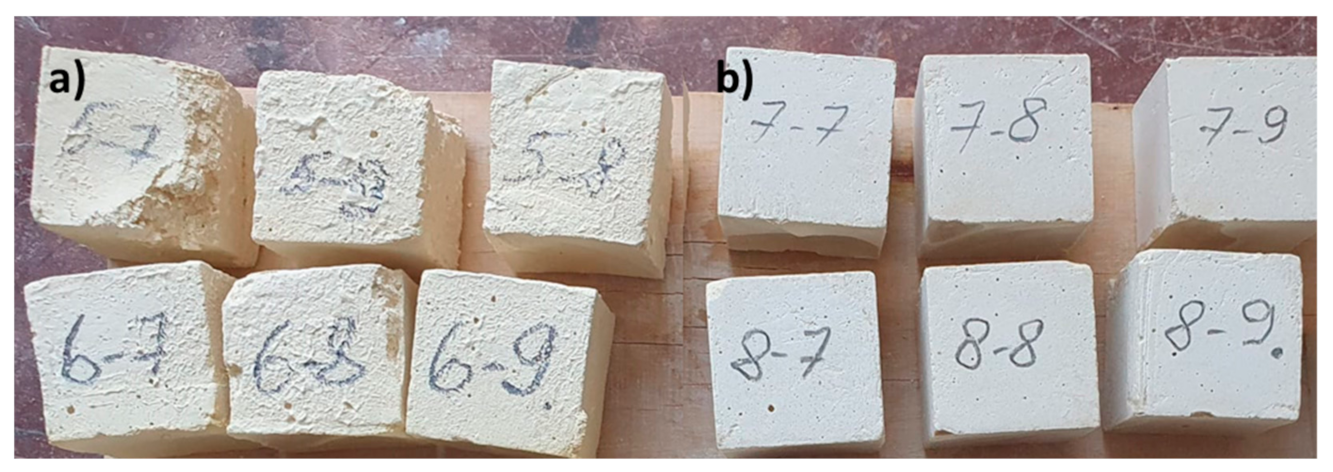
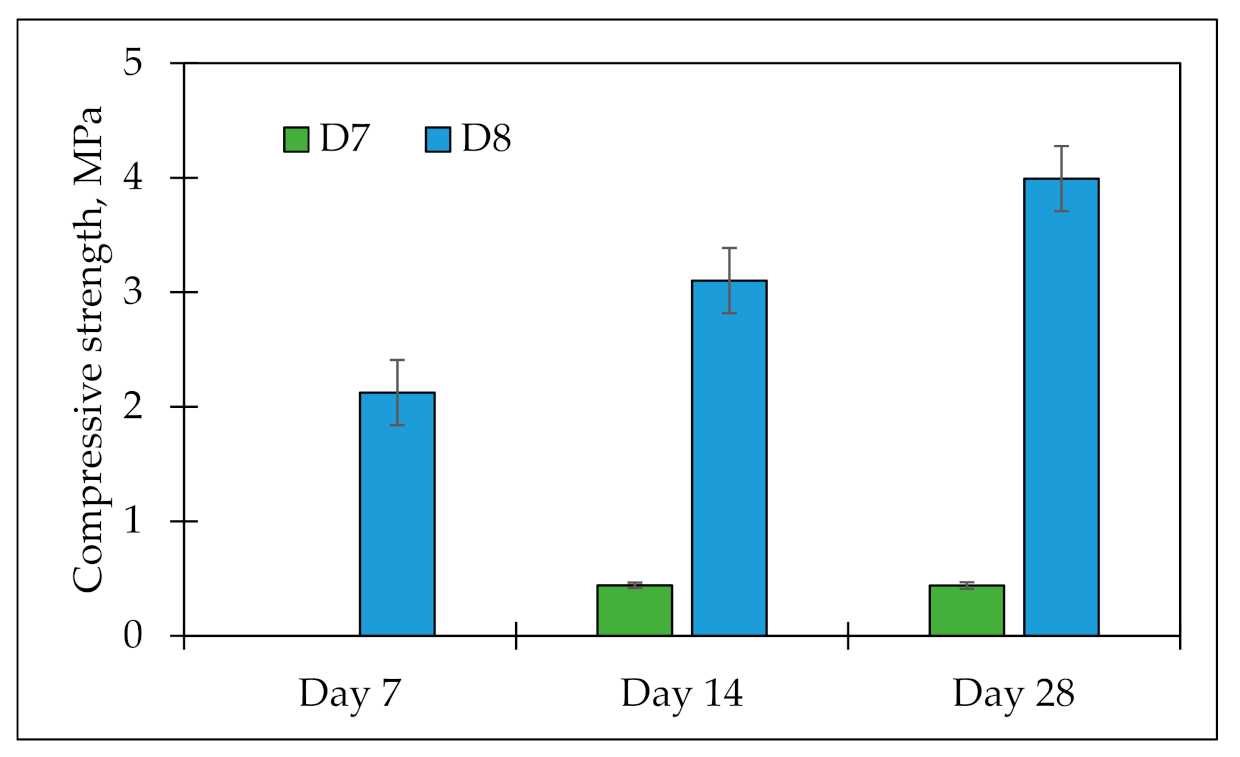

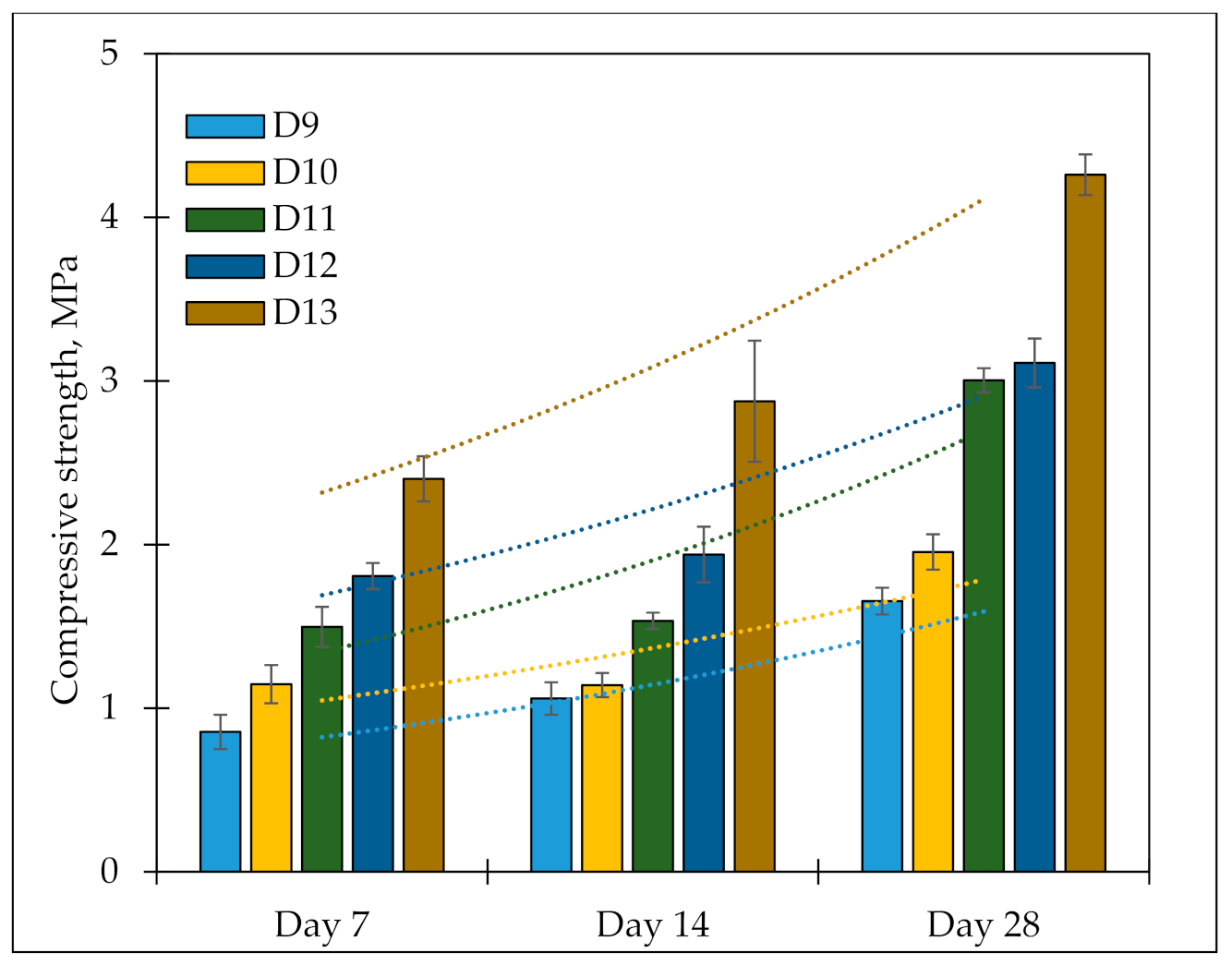

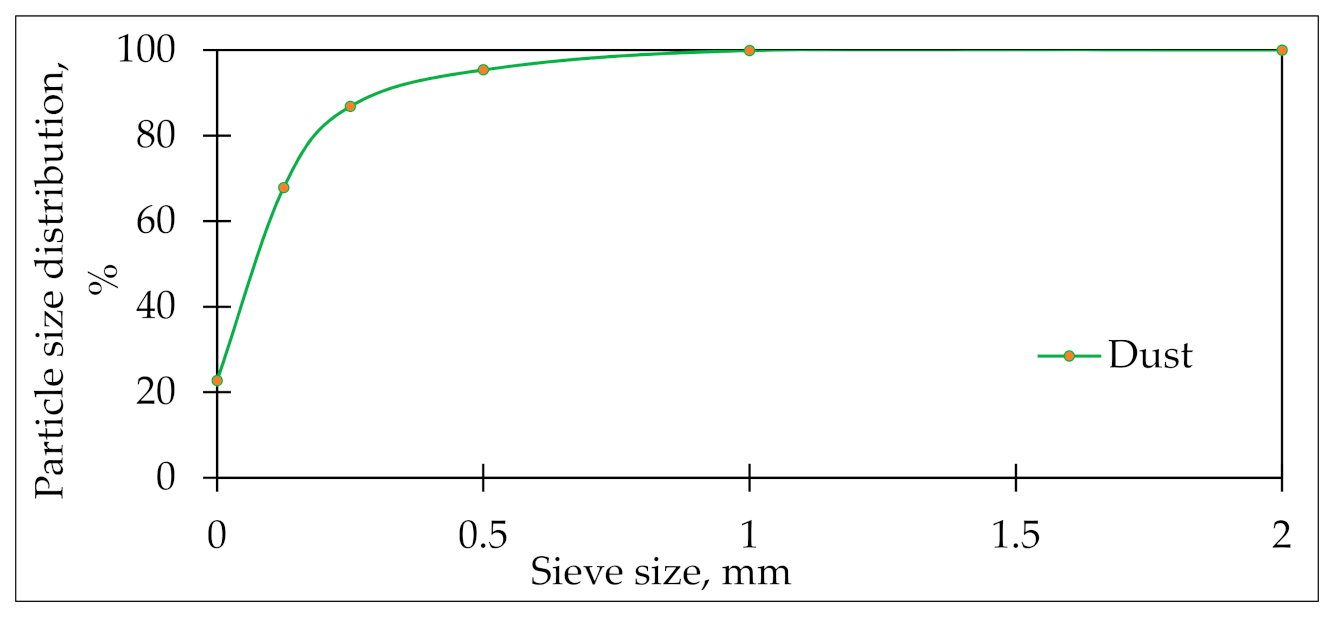
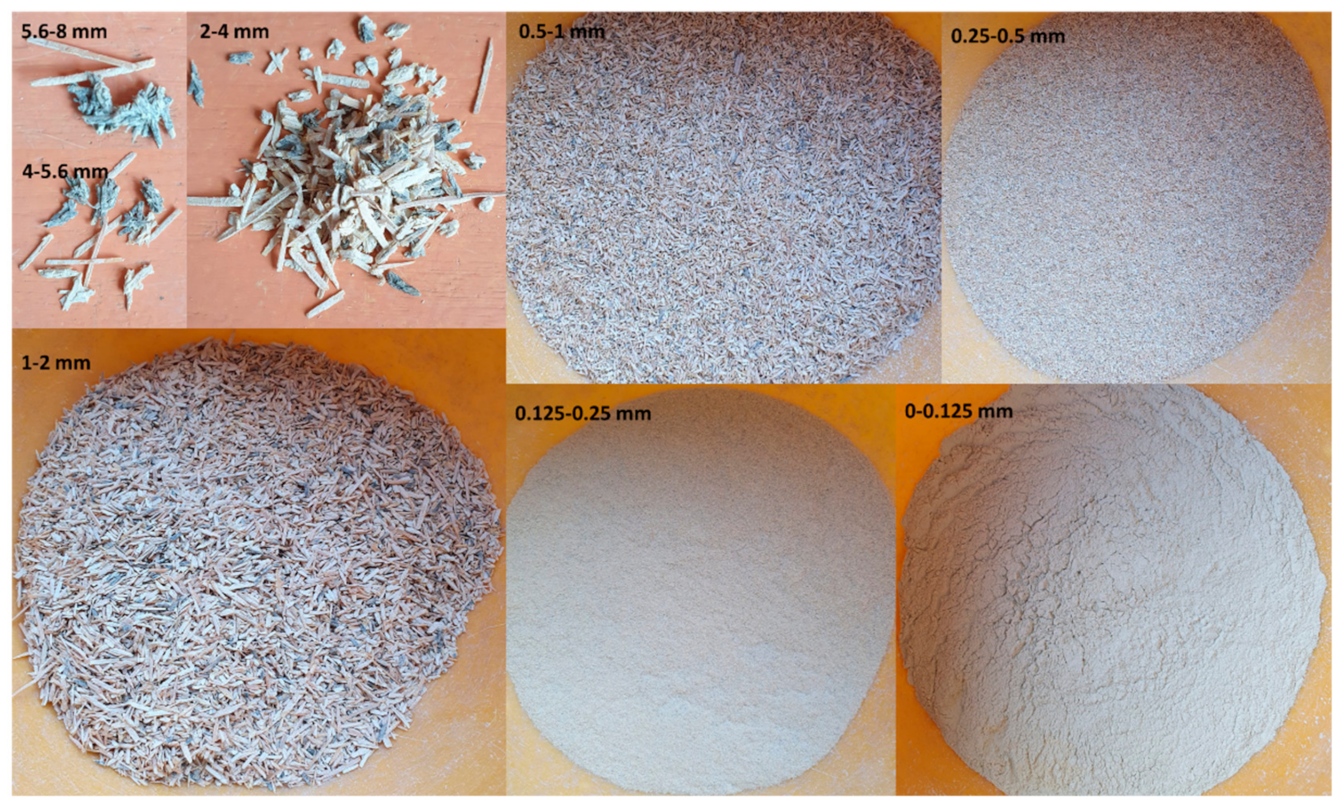


| Sample | Water/Binder Ratio | Spread Diameter after 20 Jolts, cm | Setting Start Time, Hours | Total Setting Time, Hours |
|---|---|---|---|---|
| D1 | 0.6 | 17 | 04:00:00 | 15:15:00 |
| D2 | 21 | 03:00:00 | 15:00:00 |
| Sample | Testing Day | Compressive Strength, MPa | Standard Deviation, MPa |
|---|---|---|---|
| D3 | 7 | 0.52 | 0.04 |
| D4 | 0.51 | 0.07 | |
| D3 | 14 | 0.60 | 0.02 |
| D4 | 0.66 | 0.10 | |
| D3 | 28 | 0.56 | 0.06 |
| D4 | 1.07 | 0.11 |
| Sample | Testing Day | Compressive Strength, MPa | Error, MPa |
|---|---|---|---|
| D6 | 7 | 1.37 | 0.16 |
| D5 | 3.42 | 0.20 | |
| D6 | 14 | 1.66 | 0.07 |
| D5 | 4.04 | 0.36 | |
| D6 | 28 | 1.94 | 0.13 |
| D5 | 5.01 | 0.34 |
| Sample | W/B Ratio | Spread Diameter after 20 Jolts, cm | Start of the Setting Time, Hours |
|---|---|---|---|
| D7 | 1.02 | 15 | 05:40:00 |
| D8 | 0.6 | 17 | 00:32:00 |
| Samples | Grinding Time, min | W/B Ratio | Spread Diameter after 20 Jolts, cm | Start of the Setting Time, Hours | Total Setting Time, Hours |
|---|---|---|---|---|---|
| D9 | 0 | 0.7 | 11.5 | 01:00:00 | 24:15:00 |
| D10 | 1 | 17 | 00:50:00 | 23:50:00 | |
| D11 | 2 | 19 | 00:40:00 | 23:40:00 | |
| D12 | 5 | 19.5 | 01:02:00 | 22:58:00 | |
| D13 | 10 | 19.5 | 00:32:00 | 23:03:00 |
| Sieve Size, mm | Particle Size Distribution for Dust, % | |
|---|---|---|
| Relative | Cumulative | |
| 0 | 22.73 | 22.73 |
| 0.125 | 45.10 | 67.84 |
| 0.25 | 18.98 | 86.81 |
| 0.5 | 8.56 | 95.37 |
| 1 | 4.52 | 99.89 |
| 2 | 0.11 | 100.00 |
| Unsifted Dust | Sifted Dust | Reference | ||
|---|---|---|---|---|
| Degree, °C | Explanation | Degree, °C | Explanation | |
| 50–203 | Free water, CSH gel dehydration | 50–215 | Free water, CSH gel dehydration | [52,53,56,57,58,59,60,61,62] |
| 204–364 | Organics pyrolysis, CSH dehydration | 216–390 | Organics pyrolysis, CSH dehydration | |
| 398–455 | CH dehydration | 391–451 | CH dehydration | |
| 455–514 | Dehydration of portlandite | 452–488 | Dehydration of portlandite, Ca(OH)2 dehydration | |
| 514–685 | CH dehydration/dihydroxylation, Ca(OH)2 decomposition | 489–684 | CH dehydration/dihydroxylation, Ca(OH)2 decomposition | |
| 685–785 | Calcite (CaCO3) decarbonization, emission of CO2 | 685–788 | Calcite (CaCO3) decarbonization, emission of CO2 | |
| Sample | BET Specific Surface Area, m2/g | DFT Pore Volume, cc/g | DFT Pore width, nm | BJH Pore Diameter, nm |
|---|---|---|---|---|
| N10 | 7.649 | 0.033 | 7.795 | 3.998 |
| 10 | 8.990 | 0.037 | 5.199 | 3.979 |
| 20 | 8.793 | 0.038 | 5.439 | 3.984 |
| 30 | 8.885 | 0.033 | 5.199 | 3.981 |
| Sample | W/B Ratio | Curing Conditions | Sifting of the Dust | Addition of Plasticizer * | Grinding Time, min | Representative Result Chapter |
|---|---|---|---|---|---|---|
| D1 | 0.6 | RC; WC; HHC | ✓ | ✕ | 0 | 2.1. |
| D2 | 0.6 | RC; WC; HHC | ✓ | ✕ | 10 | |
| D3 | 0.6 | HHC | ✓ | ✕ | 0 | 2.2. |
| D4 | 0.8 | HHC | ✓ | ✕ | 0 | |
| D5 | 0.6 | HHC | ✓ | ✓ | 10 | 2.3. |
| D6 | 0.6 | HHC | ✓ | ✕ | 10 | |
| D7 | 1.02 | HHC | ✕ | ✓ | 10 | 2.4. |
| D8 | 0.6 | HHC | ✓ | ✓ | 10 | |
| D9 | 0.7 | HHC | ✓ | ✓ | 0 | 2.5.1. |
| D10 | 0.7 | HHC | ✓ | ✓ | 1 | |
| D11 | 0.7 | HHC | ✓ | ✓ | 2 | |
| D12 | 0.7 | HHC | ✓ | ✓ | 5 | |
| D13 | 0.7 | HHC | ✓ | ✓ | 10 | |
| D14 | 0.7 | HHC | ✓ | ✓ | 1 | 2.5.2. |
| D15 | 0.6 | HHC | ✓ | ✓ | 10 | |
| D16 | 0.5 | HHC | ✓ | ✓ | 30 |
Publisher’s Note: MDPI stays neutral with regard to jurisdictional claims in published maps and institutional affiliations. |
© 2022 by the authors. Licensee MDPI, Basel, Switzerland. This article is an open access article distributed under the terms and conditions of the Creative Commons Attribution (CC BY) license (https://creativecommons.org/licenses/by/4.0/).
Share and Cite
Argalis, P.P.; Sinka, M.; Bajare, D. Recycling of Cement–Wood Board Production Waste into a Low-Strength Cementitious Binder. Recycling 2022, 7, 76. https://doi.org/10.3390/recycling7050076
Argalis PP, Sinka M, Bajare D. Recycling of Cement–Wood Board Production Waste into a Low-Strength Cementitious Binder. Recycling. 2022; 7(5):76. https://doi.org/10.3390/recycling7050076
Chicago/Turabian StyleArgalis, Pauls P., Maris Sinka, and Diana Bajare. 2022. "Recycling of Cement–Wood Board Production Waste into a Low-Strength Cementitious Binder" Recycling 7, no. 5: 76. https://doi.org/10.3390/recycling7050076
APA StyleArgalis, P. P., Sinka, M., & Bajare, D. (2022). Recycling of Cement–Wood Board Production Waste into a Low-Strength Cementitious Binder. Recycling, 7(5), 76. https://doi.org/10.3390/recycling7050076







